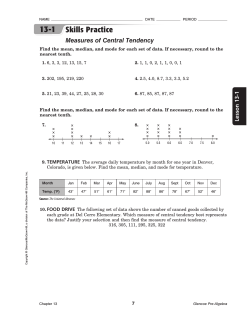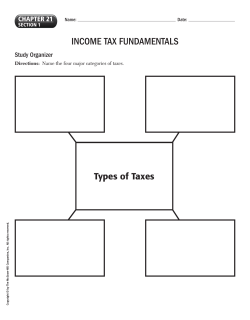
EOC Lab: Gummy Bear Genetics
Name Date Class Lab A 40 minutes Gummy Bear Genetics Imagine you are on a team of geneticists that is doing “cross-breeding experiments” with gummy bears. Unfortunately, the computer containing your data has crashed. All you have left are six gummy-bear litters that resulted from six sets of parents. But no one can remember which parents produced which litter. You know that gummy-bear traits have either Mendelian inheritance or incomplete dominance. Can you determine which parents produced each set of offspring and how gummy bear traits are inherited? Ask a Question What are the genotypes and phenotypes of the parents for each litter? Materials gummy bears calculator paper bag Safety Make Observations 1. Obtain a bag of gummy bears. Sort the bears by color (phenotype). Do not eat the gummy bears. 2. Count the number (frequency) of bears for each phenotype. 3. Combine data from your litter with those of your classmates using the data table below. 4. As a class, select a letter to represent the alleles for color. Record the possible genotypes for your bears in the class data table. Gummy Bear Cross Data for Lab Group Cross # Phenotype Frequencies EXAMPLE 15 green/5 pink Ratio Possible Genotypes Mode of Inheritance Predicted Parental Genotypes 3:1 GG or Gg/gg Mendelian Gg × Gg 1. 2. 3. 4. 5. 62 Genetics Copyright © Glencoe/McGraw-Hill, a division of The McGraw-Hill Companies, Inc. Calculate the ratio of phenotypes for each litter. Name Date Class Lab A continued Form a Hypothesis 5. Use the data to form a hypothesis about the probable genotypes and phenotypes of the parents of your litter and the probable type of inheritance. Test Your Hypothesis 6. Design and complete a Punnett square using the predicted parental genotypes Copyright © Glencoe/McGraw-Hill, a division of The McGraw-Hill Companies, Inc. in your hypothesis. 7. Compare your litter’s phenotype ratio with the ratio predicted by the Punnett square. Do your data support your hypothesis? If not, revise your hypothesis and repeat steps 5–7. Reminder Using Ratios • A ratio is a comparison of two numbers. • A ratio of 15:5 can be reduced to 3:1. Remember to use scientific methods. Make Observations Ask a Question Form a Hypothesis Test your Hypothesis Analyze and Conclude Communicate Results Genetics 63 Name Date Class Lab A continued Analyze and Conclude 8. Infer What were the genotypes of the parents? The phenotypes? How do you know? 9. The Big Idea Determine the probable modes of inheritance for each phenotype. Explain your reasoning. 10. Graph Using the data you collected, draw a bar graph that compares the phenotype frequency for each gummy bear phenotype. Copyright © Glencoe/McGraw-Hill, a division of The McGraw-Hill Companies, Inc. Communicate Your Results Create a video presentation of the results of your lab. Describe the question you investigated, the steps you took to answer the question, and the data that support your conclusions. Share your video with your classmates. 64 Genetics Name Date Class Lab B 40 minutes Gummy Bear Genetics Imagine you are on a team of geneticists that is doing “cross-breeding experiments” with gummy bears. Unfortunately, the computer containing your data has crashed. All you have left are six gummy-bear litters that resulted from six sets of parents. But no one can remember which parents produced which litter. You know that gummy-bear traits have either Mendelian inheritance or incomplete dominance. Can you determine which parents produced each set of offspring and how gummy bear traits are inherited? Ask a Question What are the genotypes and phenotypes of the parents for each litter? Materials gummy bears calculator paper bag Safety Make Observations 1. Obtain a bag of gummy bears. Sort the bears by color (phenotype). Do not eat the gummy bears. 2. Count the number (frequency) of bears for each phenotype. Then, calculate the ratio Copyright © Glencoe/McGraw-Hill, a division of The McGraw-Hill Companies, Inc. of phenotypes for each litter. 3. Combine data from your litter with those of your classmates using the data table below. 4. As a class, select a letter to represent the alleles for color. Record the possible genotypes for your bears in the class data table. Gummy Bear Cross Data for Lab Group Cross # EXAMPLE Phenotype Frequencies Ratio Possible Genotypes Mode of Inheritance Predicted Parental Genotypes 15 green/5 pink 3:1 GG or Gg/gg Mendelian Gg × Gg 1. 2. 3. 4. 5. Genetics 65 Name Date Class Lab B continued Form a Hypothesis 5. Use the data to form a hypothesis about the probable genotypes and phenotypes of the parents of your litter and the probable type of inheritance. Test Your Hypothesis 6. Design and complete a Punnett square using the predicted parental genotypes in your hypothesis. Do your data support your hypothesis? If not, revise your hypothesis and repeat steps 5–7. Reminder Using Ratios • A ratio is a comparison of two numbers. • A ratio of 15:5 can be reduced to 3:1. Remember to use scientific methods. Make Observations Ask a Question Form a Hypothesis Test your Hypothesis Analyze and Conclude Communicate Results 66 Genetics Copyright © Glencoe/McGraw-Hill, a division of The McGraw-Hill Companies, Inc. 7. Compare your litter’s phenotype ratio with the ratio predicted by the Punnett square. Name Date Class Lab B continued Analyze and Conclude 8. Infer What were the genotypes of the parents? The phenotypes? How do you know? 9. The Big Idea Determine the probable modes of inheritance for each phenotype. Explain your reasoning. 10. Graph Using the data you collected, draw a bar graph that compares the phenotype Copyright © Glencoe/McGraw-Hill, a division of The McGraw-Hill Companies, Inc. frequency for each gummy bear phenotype. Communicate Your Results Create a video presentation of the results of your lab. Describe the question you investigated, the steps you took to answer the question, and the data that support your conclusions. Share your video with your classmates. Extension Think of a question you have about genetics. For example, can you design a pedigree to trace a Mendelian trait in your family? To investigate your question, design a controlled experiment or an observational study. Genetics 67 Name Date Class Lab C Investigating Dominance in Human Traits Directions: Use the information and data from the Lab Gummy Bear Genetics to perform this lab. You have performed an activity that simulates cross-breeding experiments using gummy bears. There are many other possible questions about genetics that you could investigate. Design an observational study to investigate a human trait that shows simple Mendelian dominance. Study the trait in the members of your family and then design a pedigree to trace the trait. One example of a suitable trait is earlobe attachment. The gene for unattached earlobes is dominant whereas the gene for attached earlobes is recessive. You may also choose a different trait as long as it shows simple Mendelian dominance. Please note that you must complete Lab B before beginning Lab C. Also, have your teacher approve your design and safety precautions before beginning your experiment. Copyright © Glencoe/McGraw-Hill, a division of The McGraw-Hill Companies, Inc. 68 Genetics
© Copyright 2025









